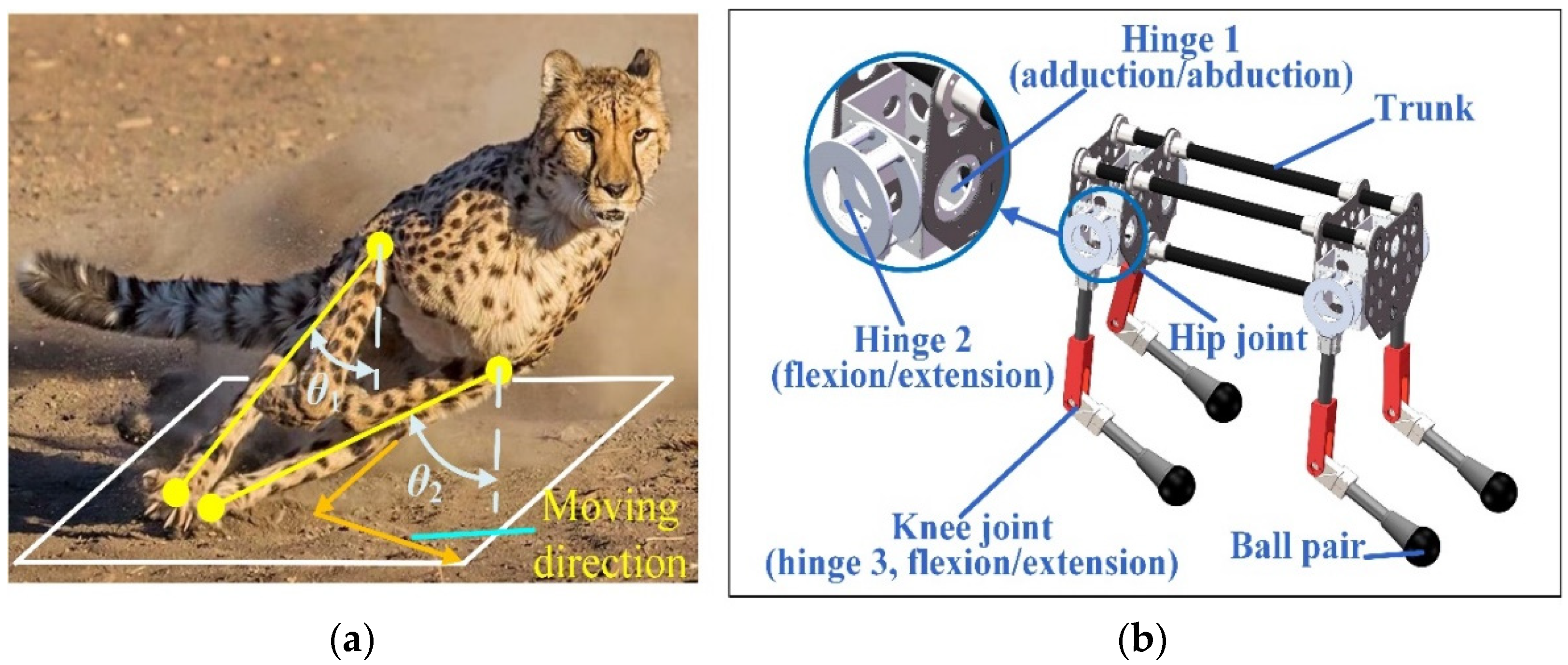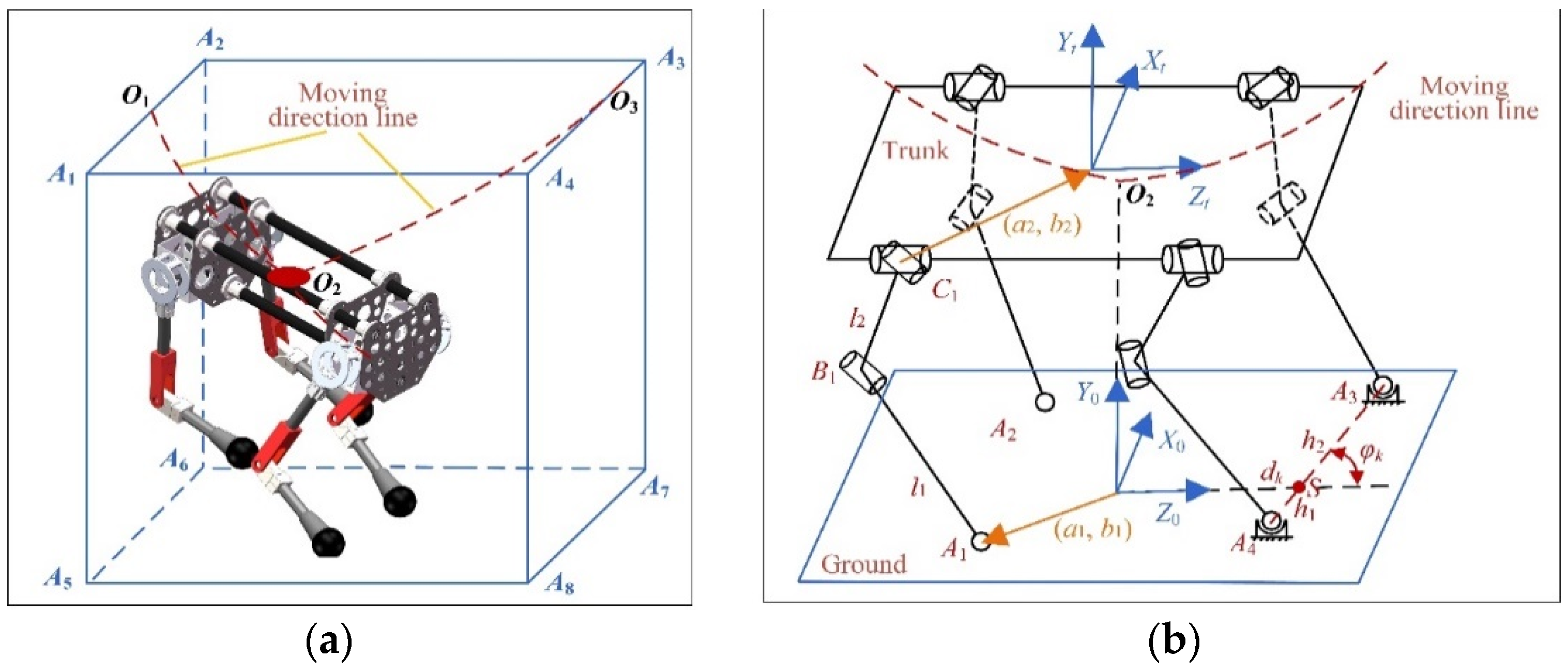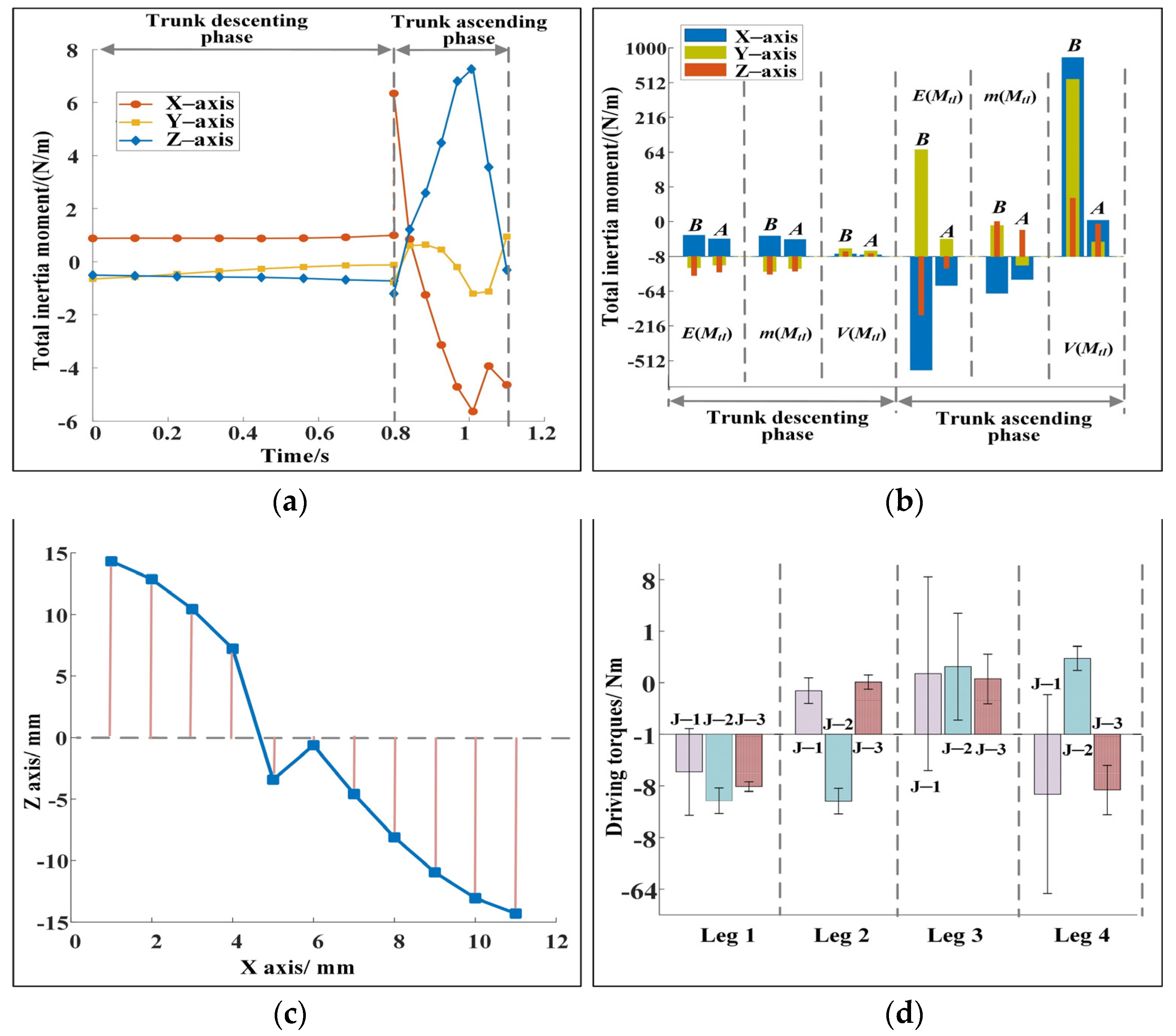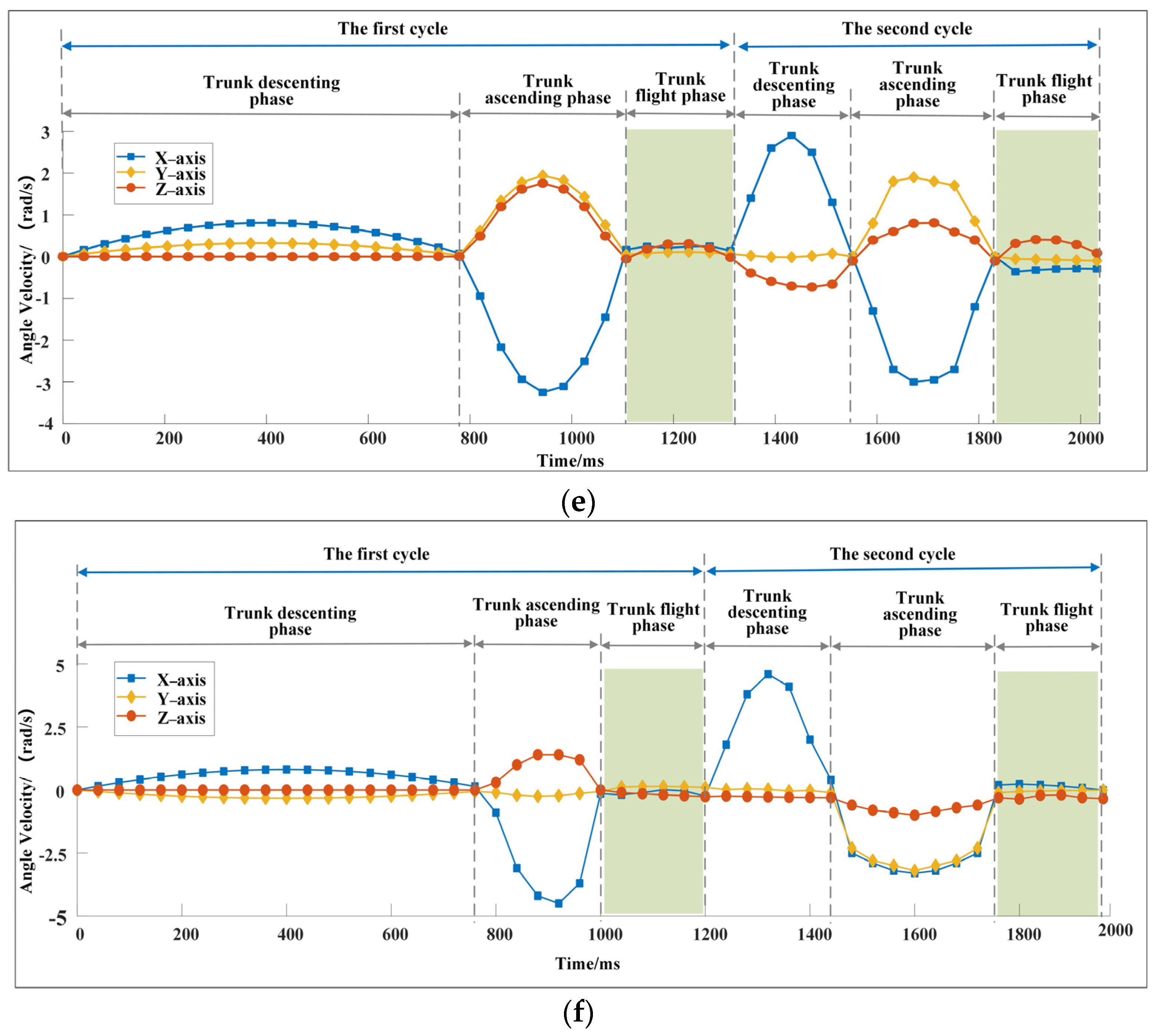Method of Changing Running Direction of Cheetah-Inspired Quadruped Robot
Abstract
1. Introduction
2. Methods
2.1. Research Objectives
2.2. Establishment of Dynamic Model
2.3. Establishment of Stability Index System
2.4. Leg parameter Optimization Method
| Algorithm 1 Leg parameters optimization | |
| Nomenclature: | Q% Ranges of optimization variables |
| W% Optimization variables | |
| Z% Optimization objective function | |
| O% Kinematic feasibility constraints | |
| M% Range constraints | |
| % Bee colony algorithm | |
| 1: | Set Qrange, Orange, Z(i)min,Z(i)max, and M |
| 2: | Forj=1, …., N1 |
| 3: | Select W(j) from Qrange |
| 4: | andM |
| 5: | If O(j) ∈Orange |
| 6: | Update Qrange,Z(i)min and Z(i)max by Z(j) |
| 7: | = Qrange Z(i)min and = Z(i)max |
| 8: | End If |
| 9: | End For |
| 10: | Forj = 1, …., N2 |
| 11: | |
| 12: | and M |
| 13: | by Z(j) |
| 14: | If N2N* |
| 15: | |
| 16: | End if |
| 17: | |
| 18: | If Z ≤ Zbest |
| 19: | Copy Z into Zbest |
| 20: | End if |
| 21: | End For |
3. Results
3.1. Examples
3.2. Simulation
4. Discussion
5. Conclusions
Supplementary Materials
Author Contributions
Funding
Data Availability Statement
Conflicts of Interest
References
- Hudson, P.E.; Corr, S.A.; Payne-Davis, R.C.; Clancy, S.N.; Lane, E.; Wilson, A.M. Functional anatomy of the cheetah (Acinonyx jubatus) hindlimb. J. Anat. 2010, 218, 363–374. [Google Scholar] [CrossRef] [PubMed]
- Lindstedt, S.L.; Hokanson, J.F.; Wells, D.J.; Swain, S.D.; Hoppeler, H.; Navarro, V. Running energetics in the pronghorn antelope. Nature 1991, 353, 748–750. [Google Scholar] [CrossRef] [PubMed]
- Park, H.W.; Park, S.; Kim, S. Variable-speed quadrupedal bounding using impulse planning: Untethered high-speed 3D Running of MIT Cheetah 2. In Proceedings of the 2015 IEEE International Conference on Robotics and Automation (ICRA), Seattle, WA, USA, 26–30 May 2015; 2015; pp. 5163–5170. [Google Scholar]
- Kropff, E.; Carmichael, J.E.; Moser, E.I.; Moser, M.B. Frequency of theta rhythm is controlled by acceleration, but not speed, in running rats. Neuron 2021, 109, 1029–1039. [Google Scholar] [CrossRef] [PubMed]
- Kamimura, T.; Sato, K.; Aoi, S.; Higurashi, Y.; Wada, N.; Tsuchiya, K.; Sano, A.; Matsuno, F. Three characteristics of cheetah galloping improve running performance through spinal movement: A modeling study. Front. Bioeng. Biotechnol. 2022, 10, 825638. [Google Scholar] [CrossRef]
- Mikolajczyk, T.; Mikolajewska, E.; Al-Shuka, H.F.N.; Malinowski, T.; Klodowski, A.; Pimenov, D.Y.; Paczkowski, T.; Hu, F.W.; Giasin, K.; Mikolajewski, D.; et al. Recent advances in bipedal walking robots: Review of gait, drive, sensors and control systems. Sensors 2022, 22, 4440. [Google Scholar] [CrossRef]
- Rubenson, J.; Sawicki, G.S. Running birds reveal secrets for legged robot design. Sci. Robot. 2022, 64, abo2147. [Google Scholar] [CrossRef]
- Kamimura, T.; Sato, K.; Murayama, D.; Kawase, N.; Sano, A. Dynamical effect of elastically supported wobbling mass on biped running. In Proceedings of the IEEE/RSJ International Conference on Intelligent Robots and Systems (IROS), Electr Network, Prague, Czech Republic, 27 September–1 October 2021; pp. 4071–4078. [Google Scholar]
- Huang, B.; Chen, W.B.; Liang, J.J.Y.; Cheng, L.F.; Xiong, C.H. Characterization and categorization of various human lower limb movements based on kinematic synergies. Front. Bioeng. Biotechnol. 2022, 9, 793746. [Google Scholar] [CrossRef]
- Bidgoly, H.J.; Vafaei, A.; Sadeghi, A.; Ahmadabadi, M.N. Learning approach to study effect of flexible spine on running behavior of a quadruped robot. In Proceedings of the 13th International Conference on Climbing and Walking Robots and the Support Technologies for Mobile Machines, Nagoya Inst Technol, Nagoya, Japan, 31 August–3 September 2010; pp. 1195–1201. [Google Scholar]
- Phan, L.T.; Lee, Y.H.; Lee, Y.H.; Lee, H.; Kang, H.; Choi, H.R. Study on effects of spinal joint for running quadruped robots. Intell. Serv. Robot. 2019, 13, 29–46. [Google Scholar] [CrossRef]
- Lee, J.; Hyun, D.J.; Ahn, J.; Kim, S.; Hogan, N. On the dynamics of a quadruped robot model with impedance control: Self-stabilizing high speed trot-running and period-doubling bifurcations. In Proceedings of the 2014IEEE/RSJ International Conference on Intelligent Robots and Systems (IROS), Chicago, IL, USA, 14–18 September 2014; pp. 4907–4913. [Google Scholar]
- Gonzalez-Luchena, I.; Gonzalez-Rodriguez, A.G.; Gonzalez-Rodriguez, A.; Adame-Sanchez, C.; Castillo-Garcia, F.J. A new algorithm to maintain lateral stabilization during the running gait of a quadruped robot. Robot. Auton. Syst. 2016, 83, 57–72. [Google Scholar] [CrossRef]
- Krasny, D.P.; Orin, D.E. Generating high-speed dynamic running gaits in a quadruped robot using an evolutionary search. IEEE Trans. Syst. Man Cybern. Part B (Cybern.) 2004, 34, 1685–1696. [Google Scholar] [CrossRef]
- Cherouvim, N.; Papadopoulos, E. Novel energy transfer mechanism in a running quadruped robot with one actuator per Leg. Adv. Robot. 2010, 24, 963–978. [Google Scholar] [CrossRef]
- Zhang, Z.G.; Kimura, H. Rush: A simple and autonomous quadruped running robot. Proc. Inst. Mech. Eng. Part I J. Syst. Control Eng. 2009, 223, 323–336. [Google Scholar] [CrossRef]
- Zhang, Z.G.; Masuda, T.; Kimura, H.; Takase, K. Towards realization of adaptive running of a quadruped robot using delayed feedback control. In Proceedings of the IEEE International Conference on Robotics and Automation, Rome, Italy, 10–14 April 2007; pp. 4325–4330. [Google Scholar]
- Zhang, Z.G.; Fukuoka, Y.; Kimura, H. Adaptive running of a quadruped robot on irregular terrain based on biological concepts. In Proceedings of the 20th IEEE International Conference on Robotics and Automation (ICRA), Taipei, Taiwan, 14–19 September 2003; pp. 2043–2048. [Google Scholar]
- Seok, S.; Wang, A.; Chuah, M.Y.; Otten, D.; Lang, J.; Kim, S. Design principles for highly efficient quadrupeds and implementation on the MIT Cheetah robot. In Proceedings of the IEEE International Conference on Robotics and Automation (ICRA), Karlsruhe, Germany, 6–10 May 2013; pp. 3307–3312. [Google Scholar]
- Hyun, D.J.; Seok, S.; Lee, J.; Kim, S. High speed trot-running: Implementation of a hierarchical controller using proprioceptive impedance control on the MIT Cheetah. Int. J. Robot. Res. 2014, 33, 1417–1445. [Google Scholar] [CrossRef]
- Park, H.-W.; Wensing, P.M.; Kim, S. High-speed bounding with the MIT Cheetah 2: Control design and experiments. Int. J. Robot. Res. 2017, 36, 167–192. [Google Scholar] [CrossRef]
- Di Carlo, J.; Wensing, P.M.; Katz, B.; Bledt, G.; Kim, S. Dynamic locomotion in the MIT Cheetah 3 through convex model-predictive control. In Proceedings of the 25th IEEE/RSJ International Conference on Intelligent Robots and Systems (IROS), Madrid, Spain, 1–5 October 2018; pp. 7440–7447. [Google Scholar]
- Melo, L.C.; Melo, D.C.; Maximo, M.R.O.A. Learning humanoid robot running motions with symmetry incentive through proximal policy optimization. J. Intell. Robot. Syst. 2021, 102, 54. [Google Scholar] [CrossRef]
- Boroujeni, M.G.; Daneshmand, E.; Righetti, L.; Khadiv, M. A unified framework for walking and running of bipedal robots. In Proceedings of the 20th International Conference on Advanced Robotics (ICAR), Electr Network, Ljubljana, Slovenia, 6–10 December 2021. [Google Scholar]
- Yang, W.S.; Lu, W.C.; Lin, P.C. Legged robot running using a physics-data hybrid motion template. IEEE Trans. Robot. 2021, 37, 1680–1695. [Google Scholar] [CrossRef]
- Leng, X.K.; Piao, S.H.; Chang, L.; He, Z.C.; Zhu, Z. Dynamic running hexapod robot based on high-performance computing. J. Supercomput. 2020, 76, 844–857. [Google Scholar] [CrossRef]
- Krasny, D.P.; Orin, D.E. Evolution of a 3D gallop in a quadrupedal model with biological characteristics. J. Intell. Robot. Syst. 2010, 60, 59–82. [Google Scholar] [CrossRef]
- Ballen-Moreno, F.; Bautista, M.; Provot, T.; Bourgain, M.; Cifuentes, C.A.; Munera, M. Development of a 3D relative motion method for human-robot interaction assessment. Sensors 2022, 22, 2411. [Google Scholar] [CrossRef]
- Wu, A.; Geyer, H. The 3-D spring–mass model reveals a time-based deadbeat control for highly robust running and steering in uncertain environments. IEEE Trans. Robot. 2013, 29, 1114–1124. [Google Scholar] [CrossRef]
- Kang, N.; Cho, J.U.; Park, J.H. Rapid change of running direction for biped robots. In Proceedings of the 14th IEEE-RAS International Conference on Humanoid Robots (Humanoids), Madrid, Spain, 18–20 November 2014; pp. 475–480. [Google Scholar]
- Sullivan, T.; Seipel, J. 3D dynamics of bipedal running: Effects of step width on an amputee-inspired robot. In Proceedings of the IEEE/RSJ International Conference on Intelligent Robots and Systems (IROS), Chicago, IL, USA, 14–18 September 2014; pp. 939–944. [Google Scholar]
- Kim, H.; Jeong, K.; Sitti, M.; Seo, T. Steering control of a water-running robot using an active tail. In Proceedings of the IEEE/RSJ International Conference on Intelligent Robots and Systems (IROS), Daejeon, Republic of Korea, 9–14 October 2016; pp. 4945–4950. [Google Scholar]
- Kohut, N.J.; Zarrouk, D.; Peterson, K.C.; Fearing, R.S. Aerodynamic steering of a 10 cm high-speed running robot. In Proceedings of the IEEE/RSJ International Conference on Intelligent Robots and Systems (IROS), Tokyo, Japan, 3–8 November 2013; pp. 5593–5599. [Google Scholar]
- Chen, R.; Yuan, Z.; Guo, J.L.; Bai, L.; Zhu, X.Y.; Liu, F.Q.; Huayan, P.; Liming, X.; Yan, P.; Jun, L.; et al. Legless soft robots capable of rapid, continuous, and steered jumping. Nat. Commun. 2021, 12, 7028. [Google Scholar] [CrossRef] [PubMed]
- Jung, G.P.; Cho, K.J. Froghopper-inspired direction-changing concept for miniature jumping robots. Bioinspir. Biomim. 2016, 11, 056015. [Google Scholar] [CrossRef] [PubMed]
- Kalouche, S. GOAT: A legged robot with 3D agility and virtual compliance. In Proceedings of the IEEE/RSJ International Conference on Intelligent Robots and Systems (IROS), Vancouver, BC, Canada, 24–28 September 2017; pp. 4110–4117. [Google Scholar]
- Shi, H.R.; Yong, X.; Liu, J.L.; Jiang, X.Y.; Jie, Y. Marsbot: A monopod robot capable of achieving three-dimensional dynamic and stable jumping. Proc. Inst. Mech. Eng. Part I-J. Syst. Control Eng. 2021, 236, 552–565. [Google Scholar]
- Yim, J.K.; Singh, B.R.P.; Wang, E.K.; Featherstone, R.; Fearing, R.S. Precision robotic leaping and landing using stance-phase balance. IEEE Robot. Autom. Mag. 2020, 5, 3422–3429. [Google Scholar] [CrossRef]
- Chiu, J.-R.; Huang, Y.C.; Chen, H.C.; Tseng, K.Y.; Lin, P.C. Development of a running hexapod robot with differentiated front and hind leg morphology and functionality. In Proceedings of the IEEE/RSJ International Conference on Intelligent Robots and Systems (IROS), Electr Network, Las Vegas, NV, USA, 24 October 2020–24 January 2021; pp. 3710–3717. [Google Scholar]
- Yamakawa, Y.; Matsui, Y.; Ishikawa, M. Development of a real-time human-robot collaborative system based on 1 kHz visual feedback control and its application to a peg-in-hole task. Sensors 2021, 21, 663. [Google Scholar] [CrossRef] [PubMed]
- Ichikawa, H.; Matsuo, T.; Haiya, M.; Higurashi, Y.; Wada, N. Gait characteristics of cheetahs (acinonyx jubatus) and greyhounds (canis lupus familiaris) running on curves. Mammal Study 2018, 43, 199–206. [Google Scholar] [CrossRef]
- Zhang, Z.; Wang, L.; Liao, J.; Zhao, J.; Zhou, Z.; Liu, X. Dynamic stability of bio-inspired biped robots for lateral jumping in rugged terrain. Appl. Math. Model. 2021, 97, 113–137. [Google Scholar] [CrossRef]
- Zhang, L.; Li, D.; Yang, F.; Liu, C. Development and attitude control of a hexapod bionic-robot. In Proceedings of the IEEE International Conference on Robotics and Biomimetics (IEEE ROBIO), Qingdao, China, 3–7 December 2016; pp. 77–82. [Google Scholar]
- Liu, Y.B.; Wang, C.B.; Zhang, H.; Zhao, J. Research on the posture control method of hexapod robot for rugged terrain. Appl. Sci. 2020, 10, 19. [Google Scholar] [CrossRef]








| Size of Thigh/[r, h]/m | Size of Calf/[r, h]/m | Size of Trunk/m | Mass of Thigh/Kg | Mass of Calf/Kg | Mass of Trunk/Kg | (a2, b2)/m |
|---|---|---|---|---|---|---|
| 0.02/0.24 | 0.02/0.28 | 0.18 × 0.2 × 0.6 | 0.2 | 0.3 | 1.8 | (0.12, 0.26) |
| v1/(m/s) | v2/(m/s) | (x1, y1, z1)/m | (x2, y2, z2)/m | Φ0/° | Ψ0/° | ZD/ZE/(Nm) |
|---|---|---|---|---|---|---|
| (0, 0, 0.22) | (1.73, 0.87, 3.26) | (0.13, 0.35, −0.2) | (0, 0.3, 0) | (25, 10, 0) | 60 | 5.0/10 |
| Initial ranges | h11/m | h21/m | dk1/m | φk1/° | h12/m | h22/m | dk2/m | |||||||
| [0, 0.2] | [0, 0.3] | [−0.1, 0.1] | [0, 180] | [0, 0.6] | [0, 0.6] | [−0.1, 0.4] | ||||||||
| φk2/° | t1/s | t2/s | a12 | a22 | d12/° | d22/° | d32/° | |||||||
| [0, 180] | [0.5, 1] | [0.1, 0.5] | [10, 61] | [0, 15] | [−15, 0] | [10, 45] | [−30, 30] | |||||||
| Optimization results | h11/m | h21/m | dk1/m | φk1/° | h12/m | h22/m | dk2/m | |||||||
| 0.17 | 0.04 | 0.08 | 74.12 | 0.10 | 0.33 | −0.02 | ||||||||
| φk2/° | t1/s | t2/s | a12 | a22 | d12/° | d22/° | d32/° | |||||||
| 53.29 | 0.8 | 0.3 | 17 | 7.55 | −13 | 32.69 | 20 | |||||||
| v1/(m/s) | v2/(m/s) | (x1, y1, z1)/m | (x2, y2, z2)/m | Φ0/° | Ψ0/° | ZD/ZE/(Nm) |
|---|---|---|---|---|---|---|
| (0, 0, 0.25) | (−1.60, 0.80, 3.00) | (0.13, 0.35, −0.2) | (0, 0.3, 0) | (25, −10, 0) | 60 | 5.0/10 |
| Initial ranges | h11/m | h21/m | dk1/m | φk1/° | h12/m | h22/m | dk2/m | |||||||
| [0, 0.3] | [0, 0.2] | [−0.1, 0.1] | [0, 180] | [0, 0.6] | [0, 0.6] | [−0.1, 0.4] | ||||||||
| φk2/° | t1/s | t2/s | a12 | a22 | d12/° | d22/° | d32/° | |||||||
| [0, 180] | [0, 1] | [0, 0.5] | [10, 61] | [0, 15] | [−15, 0] | [−45, −10] | [−30, 30] | |||||||
| Optimization results | h11/m | h21/m | dk1/m | φk1/° | h12/m | h22/m | dk2/m | |||||||
| 0.02 | 0.25 | −0.13 | 0.05 | 0.03 | 0.15 | 0.001 | ||||||||
| φk2/° | t1 | t2 | a12 | a22 | d12/° | d22/° | d32/° | |||||||
| 44.67 | 0.8 | 0.22 | 26.86 | 10 | −15 | −12 | 12.88 | |||||||
Publisher’s Note: MDPI stays neutral with regard to jurisdictional claims in published maps and institutional affiliations. |
© 2022 by the authors. Licensee MDPI, Basel, Switzerland. This article is an open access article distributed under the terms and conditions of the Creative Commons Attribution (CC BY) license (https://creativecommons.org/licenses/by/4.0/).
Share and Cite
Ning, M.; Yang, J.; Zhang, Z.; Li, J.; Wang, Z.; Wei, L.; Feng, P. Method of Changing Running Direction of Cheetah-Inspired Quadruped Robot. Sensors 2022, 22, 9601. https://doi.org/10.3390/s22249601
Ning M, Yang J, Zhang Z, Li J, Wang Z, Wei L, Feng P. Method of Changing Running Direction of Cheetah-Inspired Quadruped Robot. Sensors. 2022; 22(24):9601. https://doi.org/10.3390/s22249601
Chicago/Turabian StyleNing, Meng, Jun Yang, Ziqiang Zhang, Jun Li, Zhi Wang, Longxing Wei, and Pengjin Feng. 2022. "Method of Changing Running Direction of Cheetah-Inspired Quadruped Robot" Sensors 22, no. 24: 9601. https://doi.org/10.3390/s22249601
APA StyleNing, M., Yang, J., Zhang, Z., Li, J., Wang, Z., Wei, L., & Feng, P. (2022). Method of Changing Running Direction of Cheetah-Inspired Quadruped Robot. Sensors, 22(24), 9601. https://doi.org/10.3390/s22249601









